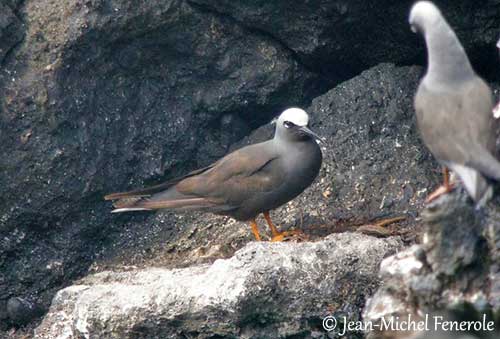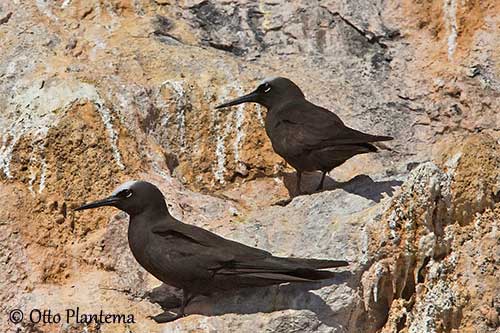
Fr: Noddi noir
Ang: Black Noddi
All: Weißkopfnoddi
Esp: Tiñosa Menuda
Ita: Noddy nero
Nd: Witkapnoddy
Sd: svart noddy
Photographers:
Jean Michel Fenerole
Photos d’Oiseaux du monde
Otto Plantema
Trips around the world
Text by Nicole Bouglouan
Sources:
HANDBOOK OF THE BIRDS OF THE WORLD Vol 3 by Josep del Hoyo-Andrew Elliott-Jordi Sargatal - Lynx Edicions - ISBN: 8487334202
Neotropical Birds – Cornell Lab of Ornithology
What Bird-The ultimate Bird Guide (Mitchell Waite)
Wikipedia, the free encyclopaedia
The Birds of North America online
Black Noddy
Anous minutus
Charadriiformes Order – Laridae Family
INTRODUCTION:
The Black Noddy is a medium-sized tern with a worldwide distribution across tropical and subtropical waters. It feeds on small fish and squid, often far out at sea. This species nests in colonies on rocky ledges, dead tree branches or bushes.
The Black Noddy is vulnerable to introduced predators such as rats and cats on the breeding islands, and the vegetation is destroyed by invasive herbivores, usually goats. Cyclones may disturb the nesting behaviour involving chick starvation, and the breeding success is reduced by the increasing temperature of the sea surface.
But currently, the Black Noddy is not globally threatened.
DESCRIPTION OF THE BIRD:
Biometrics:
Length: 35-39 cm
Wingspan: 66-72 cm
Weight: 98-144 g
The Black Noddy looks like the negative image of a typical tern. It has very dark brown plumage overall, except for the whitish forehead and crown, and the greyish nape. The long wings are pointed, whereas the tail is slightly notched.
The long, pointed bill is black. The eyes are dark brown with two white crescents, one above and the other below the eye. Legs and webbed feet are dark grey.
Male and female are similar, and the juvenile resembles adult.

SUBSPECIES AND RANGE:
The Black Noddy has seven subspecies that slightly differ in plumage tone and in size. The species is distributed in both tropical and subtropical seas. Colonies are widespread in the Pacific Ocean, but more scattered in the Caribbean, central Atlantic and NE Indian Ocean.
Both races “atlanticus” and “melanogenys” are displayed on this page.
The race A.m. atlanticus occurs on Atlantic Islands. It has darker tail. The race A.m. melanogenys has yellow-orange legs and occurs on Hawaiian Islands.
The nominate race A.m. minutus (not displayed) ranges from Papua New Guinea and N Australia, E to Samoa and the Tuamotu archipelago, including Lord Howe, Norfolk and Kermadec Islands.
The other races are A.m. worcesteri, minutus (nominate), marcusi, diamesus and americanus.
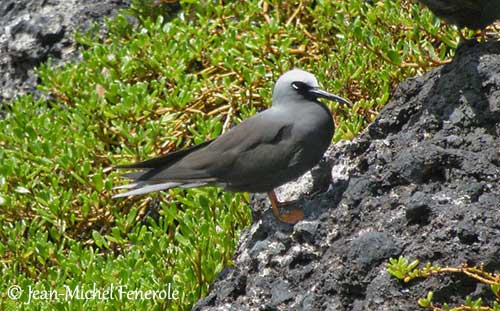
HABITAT:
The Black Noddy breeds on seacliffs, in caves, in trees or on shrubby vegetation, and also on the ground, depending on the location. The colonies are established on low sandy atolls and high rocky islands.
After breeding, they often remain near the breeding islands. However, some of them disperse by crossing the open sea to other islands.
CALLS AND SONGS: SOUNDS BY XENO-CANTO
The Black Noddy gives rapid, harsh rattle. We can also hear a sharp “kehrrr” or “crick crick crick”. The young birds give a high, thin “suwee”.
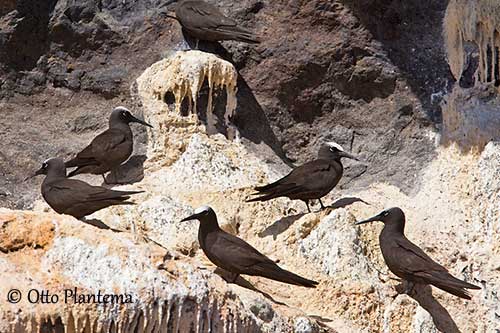
BEHAVIOUR IN THE WILD:
The Black Noddy feeds on small fish and squid caught at the sea surface. But it also dives (but does not submerge) under the surface to seize a prey.
It usually feeds in flocks and far out at sea. It may pirate food from other seabirds.
The Black Noddy feeds during the day and probably also at night. The flocks may include 20 to 3,000 individuals.
They forage by flying low over water, or by hovering, dipping and pattering their feet on the water. The prey is caught with the bill, without submerging.
The Black Noddy is monogamous and colonial breeder. During the courtship displays, both mates fly together whereas on the ground, they perform mutual head-nodding. This behaviour gives the bird its name. Courtship feeding by male to female is common, especially fish transfer. Both adults share the nesting duties.
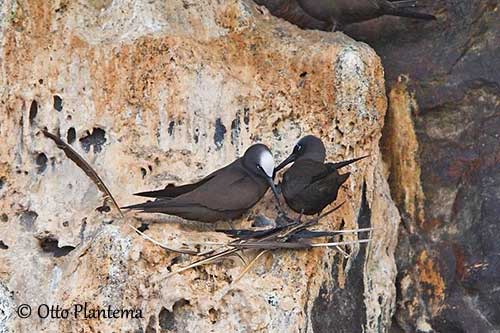
The Black Noddy is apparently resident on some islands or seasonal visitor to others. Some dispersal may occur, but the species is generally sedentary with some differences between races.
The Black Noddy flies close to the water surface, in moth-like fashion, with graceful and buoyant flight.
REPRODUCTION OF THIS SPECIES:
The breeding season varies according to the range, but it is closely related to prey availability.
The Black Noddy nests in a kind of platform with a shallow depression in the centre. It is made with sticks, leaves and seaweed, cemented by guano. It is placed up to 15 metres above the ground in tree. On the islands without trees, the bird nests on rocky ledges on seacliffs (Ascension and main islands of Hawaii).
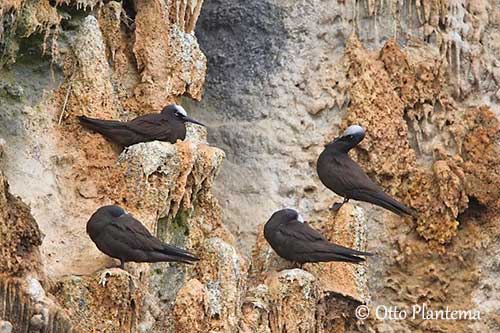
The female lays a single, creamy-white egg with brown markings. Both adults share the incubation during about 36 days and care for the chick which is brooded for several days at first. It is fed by both parents with regurgitated fish, and later with whole fish. It fledges 48-60 days after hatching but it still depends on parents for food for several weeks and returns to the nest to be fed.
Some populations (Hawaii) regularly produce two broods per season.
PROTECTION / THREATS / STATUS:
The Black Noddy is threatened by introduced cats and rats on several breeding islands, and by goats that destroy the vegetation and denude the soil. Cyclones may disturb the parental feeding, involving the death of the chick by starvation. The increase of sea surface temperature also reduces the breeding success of this species.
The population was estimated to number 1,146,000 / 2,061,000 individuals in 2018. It is suspected to be stable and the species is not globally threatened and currently evaluated as Least Concern.
